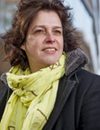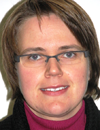
Tuesday, 15 September 201508:00 | Registration | |
Session Chair: Saskia van Ruth |
| | |
Session: Food Microbiology |
| | 09:00 | Guidelines for Harmonisation, Standardisation and Validation of Molecular Methods in Food Microbiology
Martin D'Agostino, Microbiologist, FERA, United Kingdom
A guide on how to harmonise and standardise methods in food microbiology – a case study will be presented. | 09:45 | Innovative Methods to Detect Viruses in Food
Gloria Sanchez, Research Scientist, Institute of Agrochemistry and Food Technology, Spain
The potential of viability PCR, ethidium and propidium monoazide pretreatment, for infectious virus detection will be reviewed. | 10:30 | Coffee and Networking | 11:00 | CANCELLED DUE TO FLIGHT DELAYS - Application of Pyrosequencing to the Microbial Ecology Foods
Martin Wagner, Professor, University of Veterinary Medicine, Austria
Sequencing has completely changed the insight in the composition of microbial communities in the recent years. This presentation shows the importance of increasing our understanding how metabolically active parts of microbial communities are transferred from raw stuffs or environments to food under processing. | 11:00 | What's New in Food Microbiology Diagnostics: A Molecular Perspective
David Rodriguez-Lazaro, Associate Professor, University of Burgos, Spain
The traditional microbiological techniques are not sufficiently rapid to assure the safety of foods at consumption. Molecular methods are one of the most promising alternative techniques for the rapid detection of microorganisms in food improving the likelihood of detecting foodborne pathogens. | 12:30 | Lunch & Networking | 13:30 | Poster Session | |
Session Chair: David Rodriguez-Lazaro |
| | |
Session: Food Authenticity |
| | 14:00 |  | Keynote Presentation Faith in Food or Dining on Deception?
Saskia van Ruth, Professor, Wageningen University, Netherlands
No one likes to be deceived. Control of food fraud in industry requires vulnerability assessments. Identified food fraud vulnerabilities resulting from existing opportunities and motivations can be counteracted by hard controls, e.g. novel analytical methodology. |
| 14:45 | Tracing the Dietary Background and Geographical Origin of Animal-derived Foods
Frank Monahan, Associate Professor, University College Dublin, Ireland
The presentation will focus on the application of stable isotope ratio analysis and chromatographic and spectroscopic techniques to the assignment of dietary background and geographical origin of animal-derived foods, particularly meat. | 15:45 | Coffee and Networking | 16:15 | Brand Protection, Quality Assurance and PAT. How can Vibrational Spectroscopy Help?
Gerard Downey, Professor, Teagasc Food Research Centre, Ireland
The potential of vibrational spectroscopic techniques to underpin protection of food quality and company brands through deployment of PAT tools will be discussed with reference to particular food quality examples. | 17:00 | End of Day 1 | 17:30 | Prosecco and Punting on the River Cam |
Wednesday, 16 September 2015 |
Session Chair: Jens Sloth |
| | 09:00 | The Fight Against Food Fraud: The Analytical Tool Box
Simon Kelly, Laboratory Manager, University of East Anglia, United Kingdom
UK food producers, retailers, regulators and consumers were left reeling in the wake of the horse meat scandal in the UK. “Horsegate” has amplified interest in all aspects of Food Authenticity and Provenance. This presentation gives a brief overview of some of the latest analytical tools developed to inform regulators, producers and consumers regarding the authenticity of foods and to help protect against food fraud. | |
Session: Emerging Issues |
| | 09:45 | Detection and Characterization of Nanoparticles in Food and Biological Materials
Katrin Loeschner, Senior Researcher, Technical University of Denmark, Denmark
The experimental challenges will be highlighted and an outlook into future research will be given. | 10:30 | Coffee and Networking | |
Session: Food Allergens |
| | 11:00 | | |
Session: Contaminants |
| | 11:45 | How to Overstep Matrix Effects for Pesticides Detection Residues
Geraldine Giacinti, Researcher, Institute National Polytechnique de Toulouse, France
Pesticides residues were quantified by GC-MS2 with hot splitless injection in fruits and in fruit peels matrixes. Matrix effects are taken into account in the quantitation of pesticides residues, leading to more investigated pesticides in peels, highlighting cross contamination of pesticides. | 12:45 | Lunch & Networking | 13:30 | Poster Session | 14:00 | Accumulation and Translocation of Macro, Micronutrient, Non-essential and Toxic Elements by Swiss Chards (Beta Vulgaris Subspecies Cycla) Grown up in an Open-air Plot Under Organic or Conventional Farming Techniques
Olaia Liñero Campo, PhD Student, University of the Basque Country (UPV/EHU), Spain
The behaviour of several elements within the chard plant during a five month garden experiment is studied: implementing and maintaining two plots using organic and conventional fertilisers and products. All the obtained results are discussed in terms of food safety and risk associated to the consumption of leafy vegetables. | 14:45 |  | Keynote Presentation EFSA’s Risk Assessments on Contaminants in the Food Chain
Katleen Baert, Scientific Officer, European Food Safety Authority, Italy
The EFSA Panel on contaminants in the food chain (CONTAM Panel) carries out risk assessments in the area of chemical contaminants in food and feed, namely process contaminants, environmental contaminants, natural toxicants, mycotoxins and residues of unauthorised substances. |
| 15:30 | Coffee and Networking | 16:00 |  | Conference Chair Trace Element Speciation Analysis
Jens Sloth, Senior Scientist, Technical University of Denmark, Denmark
The presentation will aim at providing an overview of the status and recent development within trace element speciation analysis in food. |
| 16:45 | Close of Conference |
|

 Add to Calendar ▼2015-09-15 00:00:002015-09-16 00:00:00Europe/LondonFood Analysis CongressFood Analysis Congress in Cambridge, UKCambridge, UKSELECTBIOenquiries@selectbiosciences.com
Add to Calendar ▼2015-09-15 00:00:002015-09-16 00:00:00Europe/LondonFood Analysis CongressFood Analysis Congress in Cambridge, UKCambridge, UKSELECTBIOenquiries@selectbiosciences.com